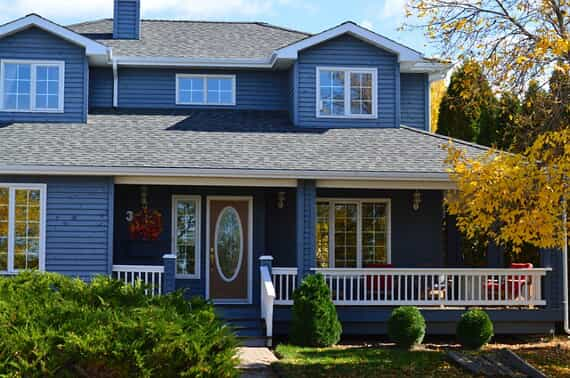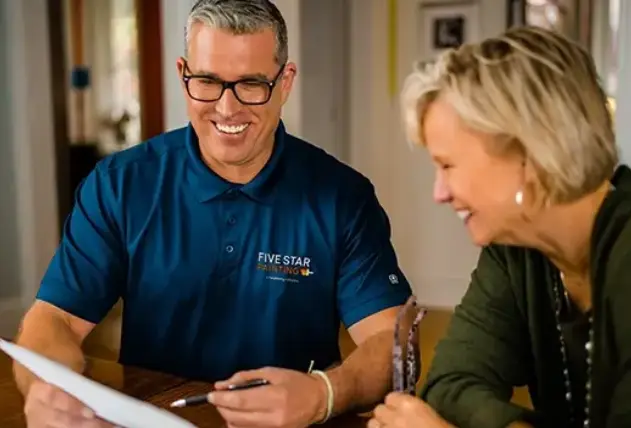
Five Star Painting highlights key mistakes to avoid when choosing exterior paint.
|
Painting your own home’s exterior may seem like a good idea. Running through the scenario in your mind, you probably think there’s not much to it, especially if you’re only planning on painting some trim here and there. However, there are a lot of pitfalls and issues you can encounter when you take on such a task. Knowing what mistakes to avoid before you start the job, like the best exterior paint to choose, can save you a few headaches and a few dollars.
In this article, we share some common mistakes you might make when you take on this type of painting job. Having all the information before you start can also help you choose just the right paint for the job and help you avoid the costly mistake of having to do it all over again.
Not Considering Weather
When you think about choosing the right type of exterior paint, one of the main things you must consider is the climate. Heavy rainfall and constant exposure to the sun can really take a toll on an exterior paint finish. Does your house receive a lot of shade from trees throughout the day, or is it constantly exposed to the sun? Some exterior paint finishes hold up better than others when exposed to the elements over an extended period of time. Ultraviolet rays will deteriorate the binders in inferior paints. This causes them to breakdown and be released in the form of a powder that gets washed away by rain, resulting in a faded finish. Prolonged exposure to moisture causes inferior paint formulas to soften and swell, leading to cracking, blistering, and flaking.
Read Also: Paint as Protection Against Weather and Insect Damage
Choosing the Wrong Type of Exterior Paint
As mentioned, the type of exterior paint you choose will depend heavily on factors like weather and moisture conditions in your area. Deciding between a latex or oil-based paint is one of the most important decisions you will have to make. For example, you should never put latex paint over a coat of oil-based paint. It will not stick, and you will end up with paint peeling off your home exterior. Although a high-quality paint may cost you a little more, it’s definitely worth it in the long run. A high-quality paint will hold up better to the elements and retain its original color and consistency over a longer period of time, which means you won’t have to paint as often.
Ignoring Neighboring Houses’ Colors
A key step in picking exterior paint is choosing colors that are not only going to compliment your home, but your neighbors’ homes as well. The last thing you want is to choose colors that completely clash with your neighbors’ houses and ruin the whole aesthetic of the neighborhood. Many HOAs even have rigid guidelines when it comes to exterior paint colors, so it is best to consult with your local community board or HOA to understand the regulations regarding 'approved’ exterior paint colors.
Choosing Color Based on Printed Samples Instead of Actual Paint Samples
Printed paint samples are a good way to get a general idea of what a color will look like once it dries. But the only way to know for sure how a paint color will look is to see it on the actual material it will be covering. Different types of wood and other material absorb paint in a variety of ways, and this can change the color slightly, and in some cases drastically. If possible, bring a sample of the material you will apply the paint to when choosing a color to see how it will look on your house. If you can’t get a sample of the material, buy a small amount of the paint you are considering and apply it to a small area of your house exterior—one that is less visible. Let the paint dry for a day or two and then determine if the color meets your expectation. If so, you can buy the rest of the paint you need.
Failure to Properly Prep the Surface
How you prepare the surface of your home’s exterior will affect the paint you choose for your home exterior and determine the type of paint coverage you need. If the exterior of your house is prepped correctly, a one-coat paint can usually be applied. However, if the surface of your home has not been properly prepared for painting you may find you need to apply more than one coat of paint. This can add considerably time and cost to the entire job, which could put you off schedule and over budget. Your home must be properly cleaned, sanded and primed in order for the paint you choose to stick and have the longevity that you are looking for. Applying the right techniques during these steps will affect which paint you choose and how your exterior paint job turns out.
Read Also: Evaluating Exterior House Painting Professionals - What You Need to Know
Ignoring Personal Safety Concerns
Painting a house requires a lot of preparation and activities that can be considered dangerous. Climbing up and down ladders with brushes, rollers and paint, and being exposed to paint particles and fumes are some of the potential hazards you will have to deal with when choosing a type of paint. If you choose a paint that can be applied using a sprayer you should know that some exterior paints have a higher concentration of Volatile Organic Compounds (VOC’s), which release hazardous compounds in the form of gases. Since VOC’s are the main active chemical in many exterior paints, it's important to note they can be harmful if inhaled over an extended period, causing eye irritations, headaches, dizziness and fatigue. This is far more likely when using an electric paint sprayer as it is released a fine paint mist into the air. But there are some low VOC and non-VOC paint options available. One way to avoid any concerns about the VOC level in your paint is to hire a local professional to paint your house exterior.
Not Using a Professional
Painting the exterior of your house is an ambitious project, even if you’re an advanced DIY’er. But before you pick up the first brush, wet a roller or fill the sprayer, choosing the right paint for this painting project is one of the most important factors for success. And when it comes to choosing the right paint there are a lot of things to consider. Your climate, exposure to the elements, surface type, HOA and how you intend to apply the paint are some of the things that will influence your choice of paint.
Painting a house exterior is no small task. It can be stressful, time consuming and costly if you don’t get it right the first time. So if you’re feeling a little overwhelmed by the thought of painting your house, it’s time to consider hiring a local professional like Five Star Painting. Five Star Painting has the experience and expertise to help you choose just the right color and type of paint to make your home the pride of the neighborhood.


